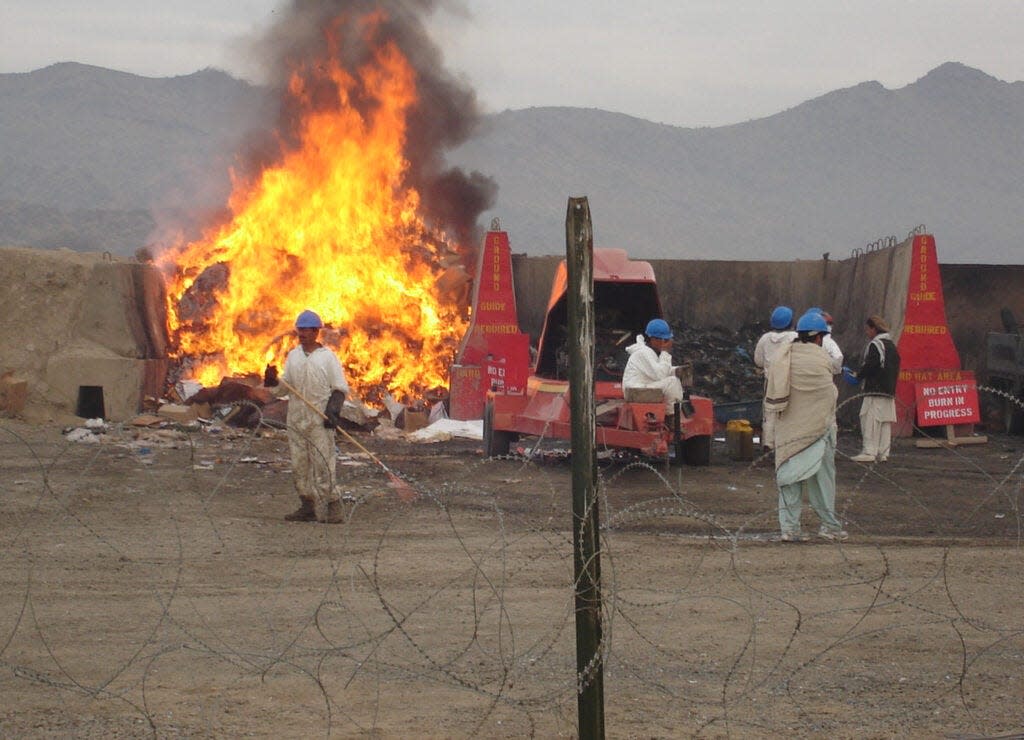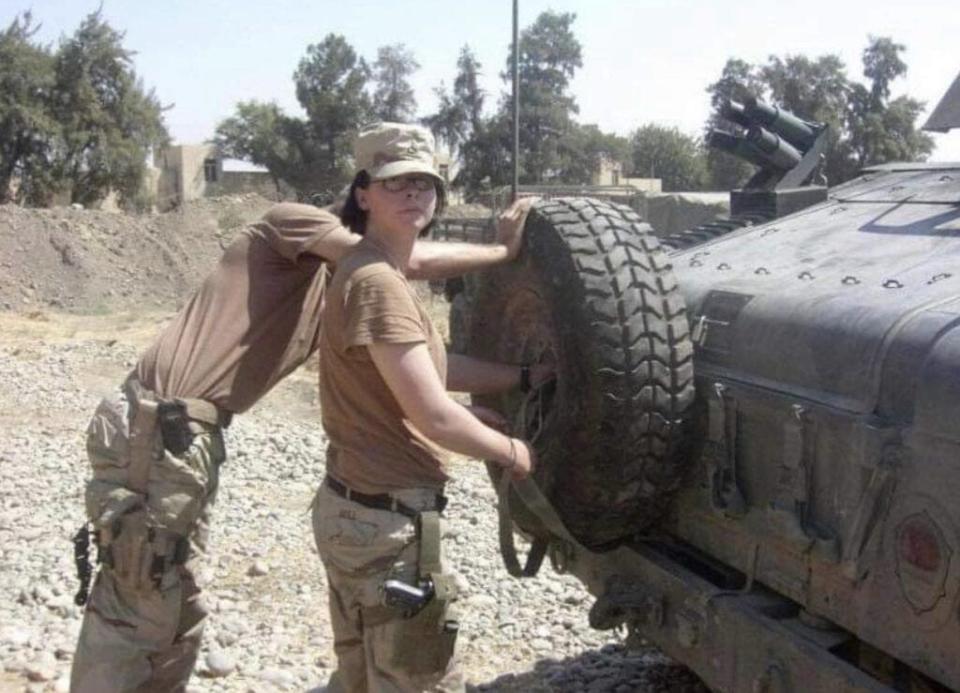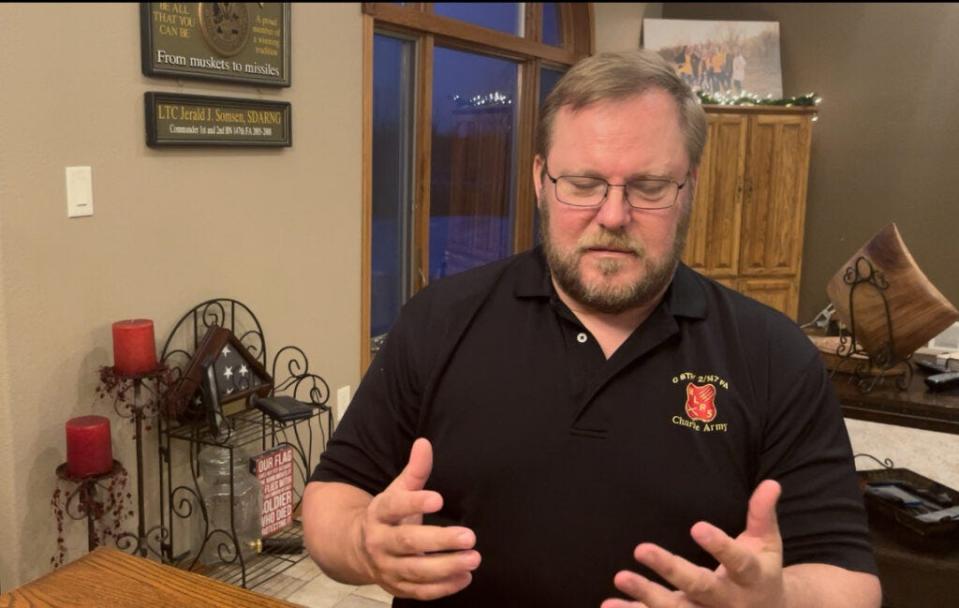Burn pit bill now law, but some SD veterans might still struggle to get needed health care

- Oops!Something went wrong.Please try again later.
Combat veterans in South Dakota are encouraged by new legislation in Congress to expand treatment and benefits for soldiers exposed to toxic burn pits during deployment overseas
But questions remain about the federal government’s ability to effectively provide the needed health care.
More: New, more contagious COVID-19 variant raising concerns in South Dakota
Those questions partly explain why Republican U.S. Sens. John Thune and Mike Rounds of South Dakota opposed the Honoring our Promise to Address Comprehensive Toxics Act, commonly called PACT Act, initially voting against it twice before public pressure and an agreement to consider GOP amendments swayed their votes to the yes column on Aug. 2.
The measure passed the Senate by a vote of 86-11, clearing the way for President Joe Biden to sign it into law Aug. 10.
'We want to make promises we can actually keep'
“We want to make promises that we can actually keep,” Rounds told News Watch, referring to backlogs in Department of Veterans Affairs processing that have delayed health care claims and referrals, sparking recent controversy and a change of VA leadership in Sioux Falls. “The VA has made it very clear that it can’t handle the influx of additional veterans that are going to be coming forward.”
The PACT Act expands health care eligibility to about 3.5 million veterans exposed to toxic smoke from burn pits used to dispose of chemicals, munitions and other hazardous materials, mostly in Iraq and Afghanistan, while also extending coverage for illnesses linked to the Agent Orange herbicide in Vietnam.
More: 24/7 Sobriety program developed in South Dakota could be rolled out nationwide
With an estimated cost of $280 billion over 10 years, the measure also directs more funding toward VA health care centers and claims processing, though Rounds and Thune say such efforts will fall short of meeting the increased demand in South Dakota, which has nearly 56,000 veterans, comprising 8.5% of the state’s total population, higher than the national average of 7.1%, according to the 2020 U.S. Census.
U.S. Rep. Dusty Johnson, R-S.D., cited the similar logistical concerns while voting against the PACT Act in the House of Representatives, where it passed by a margin of 342-88 in July.
Tom Hafner, state commander of Veterans of Foreign Wars in South Dakota, admitted that procedural issues exist but said those concerns should not have caused South Dakota’s congressional delegation to oppose the groundbreaking veterans aid package.
Concern should have been 'what was good for the veterans of South Dakota'
“I was disappointed,” said Hafner, 73, who served as command sergeant major of his Army National Guard unit during Operation Iraqi Freedom in 2004-05. “They talk about taking care of veterans, and this was one area where that could happen. Whether the VA can adapt or handle more cases shouldn’t have been their concern at the congressional level. Their concern should have been what was good for the veterans of South Dakota.”
Hafner recalled burn pits being a “common, everyday occurrence” during his time in Iraq with the 153rd Engineer Battalion out of Huron. He is one of nearly 24,000 veterans in South Dakota who served in either the Persian Gulf War or post-9/11 operations in Iraq and Afghanistan.
“I would venture to say that nearly every veteran who was deployed to Iraq was exposed to some sort of toxic fumes,” said Hafner, who lives in Parkston. “You’d go by burning oil pits that were smoldering constantly, and there was no way to get away from it. But I don’t think anybody thought anything of it, except in hindsight.”
Hafner suffers from rhinitis, a respiratory condition that causes congestion and makes it difficult to breathe at night. The VA last year added rhinitis and chronic asthma to its list of presumptive conditions, meaning Gulf War era and post-9/11 veterans diagnosed with the ailment are presumed to have gotten it from military service and are covered for treatment through the VA.
The PACT Act adds 23 illnesses to the list of presumptive conditions, including brain cancer, pancreatic cancer and lymphoma. Before this legislation, many veterans have faced situations where they had to prove that their ailments were linked to military service, using VA clinic visits and an appeal process.
This comes at a time of greater recognition of mental illness in the military, with suicide rates of military service members and veterans spiking in recent years, according to U.S. Department of Defense data.
“When you’re that young, it’s all about the mission,” said Connie Johnson, who served in the Army as part of Operation Iraqi Freedom in 2003-04. “You do what you’re told and serve your country and you’re not thinking about your health. Then 10 or 15 years later your body is like, ‘Now you’re going to pay for it,’ whether that’s physically or mentally. And we’re paying for it now.”

Greater awareness about burn pits and broader access to care is important, Connie Johnson added. But expanding the number of veterans who are eligible for care without addressing flaws in the system has her worried about more procedural bottlenecks and more pain and frustration.
“The VA can’t handle us already,” said Johnson, a 38-year-old Elkton native who serves as president of the South Dakota Veterans Council. “I’m worried that it’s just going to cause more heartache.”
Webster veteran holds out hope for the future
For Jerry Somsen, the passing of burn pits legislation in Congress is not a time of celebration, but cause for further reflection. The 54-year-old Webster native, who helped command an Army National Guard battalion during Operation Desert Storm from 2003-05, started experiencing tremors in his hands after returning home from Iraq, where he and other soldiers regularly encountered smoke on the compound from burning waste and munitions.
When the shaking spread to both sides of his body and down his legs, Somsen was diagnosed with Parkinson’s disease, a progressive nervous system disorder, though he has no family history with the disease.

“I didn’t have this when I went over there, and I came out knowing something was wrong,” the insurance executive said. “I guess you could say we signed up for it, but we didn’t sign up to not be protected once we got back.”
Somsen receives medication for his condition through the VA but has been denied disability benefits because the VA does not recognize Parkinson’s as being connected to burn pit exposure, citing research from the National Academy of Sciences, Engineering and Medicine. The illness is not listed among the presumptive conditions added by the passage of the PACT Act, either, so Somsen’s disability status has not changed.
“Parkinson’s is basically falling through the cracks,” he said the day after the bill passed the Senate.
But Somsen, who retired in 2009 after 23 years of National Guard service, sees a lot of positives from recent attention paid to the burn pits issue
“Anything we can do to help veterans out is what I’m after,” he said. “It’s amazing how many people have reached out to me to talk about what they’re going through, whether it’s neck cancer or respiratory illness or melanoma. I’m glad that people are going to get help, but it’s unnerving to hear about all the stuff that’s out there and wonder if something couldn’t have been done earlier.”
Bureaucratic bottlenecks for veterans
Johnson received the Army Commendation Medal and a Purple Heart for injuries suffered when her 101st Military Police Company convoy was struck by a roadside bomb in northern Iraq. She was able to return to duty but dealt with nerve damage and post-traumatic stress disorder after returning to South Dakota, with scars on her neck as a remnant of war.
Because of her documented injuries and medals, Johnson’s experience with continuing care through the VA was mostly positive. But as she became more active in advocating for veterans throughout the state, she realized that her situation was not necessarily the norm.
More: Inflation putting most pain on South Dakotans who make the least
“I had access that many veterans didn’t have,” said Johnson, a South Dakota State University alum who serves as the school’s coordinator of veteran affairs. “There are people, some of whom went through more than I experienced, who have had to scratch and claw their way into the system. That’s a serious flaw in the process.”
Many of these issues stem from implementation of the VA Mission Act of 2018, which established a Community Care program with the aim of integrating VA medical facilities with private doctors and clinics. This partial privatization was meant to allow more veterans, especially those in rural or remote areas, to receive care without having to physically travel to a VA facility.
But Rounds, one of just five senators to vote against the Mission Act in the Senate, points out that the process creates bureaucratic hurdles. Appointments and claims still must be processed and approved through Veterans Affairs, which in many cases lacks the staff and infrastructure to meet the demand, Rounds said.
“They put gatekeepers in place to keep veterans away from local doctors,” said Rounds, who attended a forum in Sioux Falls in February 2022 to hear veterans air grievances about Community Care in the Sioux Falls VA Health Care System, which serves about 30,000 enrollees. “We wanted to open it up so vets could go to the doctor of their choice and the VA would pick up the bill.”
In September 2020, the U.S. Government Accountability Office released a review of the Community Care program nationally, noting that the VA had not established a “timeliness goal” for veteran care and that the program was understaffed in many locations. It also pointed out that few community providers were using the VA’s software system to exchange information electronically, leading to backlogs and extended wait times for claims or appointments.
More: Scholastic Stars: Schaefer has already started a career of service
Earlier this year, Lisa Simoneau was reassigned as director of the Sioux Falls VA Health Care System amid concerns about the program, including reports that some vets were placed on hold for nearly an hour as they tried to make appointments. The acting director is Dr. Timothy Pendergrass, who was not made available for an interview with News Watch. Pendergrass said in a statement that the longest wait time for the week of July 25-29 was four minutes, and the average time a scheduler was on the phone was 3:39, according to Sioux Falls VA data.
“We continue to make improvements to provide the best care for our veterans,” Pendergrass wrote in the statement. “Reducing call times was one of our main priorities since this issue was identified and over the last six months, we have made significant changes and improved processes to make scheduling care in the community easier for veterans.”
This article originally appeared on Aberdeen News: Veterans might need better health care access even after burn pit law

